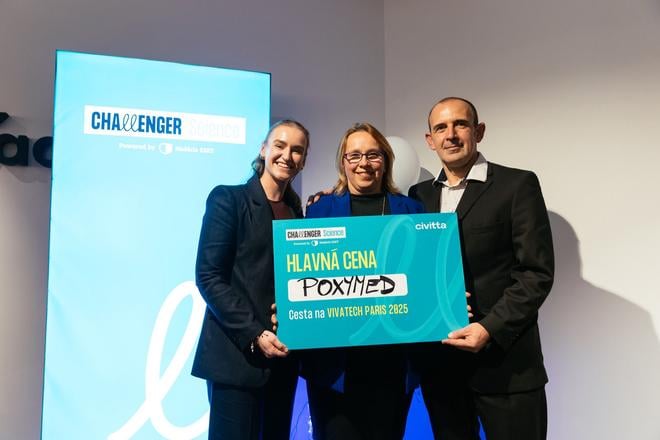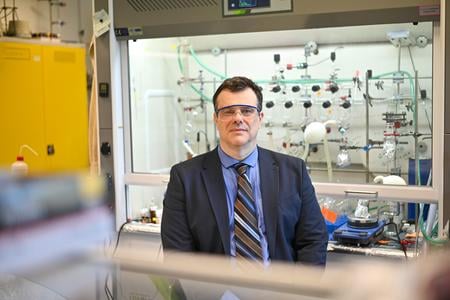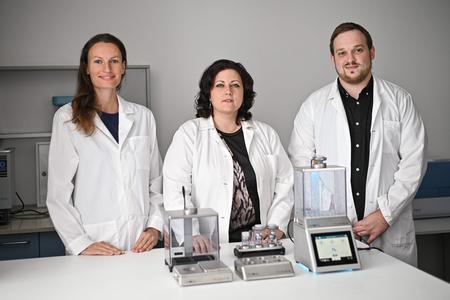At the end of 2024, team PoxyMed from the Polymer Institute of the Slovak Academy of Sciences (SAV) won the first edition of Challenger Science, a programme that bridges the gap between business mindset and scientific research.
PoxyMed, consisting of principal scientist Juraj Kronek, biologist Zuzana Kroneková and PhD student Alžbeta Minarčíková, is researching the use of polymers as a platform to deliver drugs more effectively. In this interview, Juraj Kronek (J. K.) and Zuzana Kroneková (Z. K.) talk about the specific polymer they use, what makes it special, in what kind of treatment it can be used, and what they got from Challenger Science.
Minarčíková, who is currently studying in Switzerland, oversaw most of the experiments and provided a lot of feedback to get the reactions up and running, as well as determining how to communicate the research to the general public.
What kind of polymer carriers are you researching?
J. K.: We have been working on poly(2-oxazoline)-based carriers, which are capable of forming stable nanoparticles necessary for long-term treatment. They can effectively encapsulate the drug, mRNA or DNA, and then are used for their targeted delivery and controlled release. Currently, lipid or viral nanoparticles are mainly used, which are known from the Covid-19 pandemic and are used in the production of vaccines.
What is this polymer you are talking about?
J. K.: Poly(2-oxazoline)s are a specific type of synthetic polymers. The biggest advantage is that although produced synthetically, they have a very similar structure to proteins. In contrast to proteins, the immune system does not recognise this kind of polymers in the body, therefore antibodies and other regulatory molecules against the polymers are not produced. It means delivery of drugs encapsulated in these polymers is safe with minimal side effects and does not influence the effect of the drugs we use.
Also at the Polymer Institute at the Slovak Academy of Sciences, Igor Lacík's team is researching the use of polymers in the treatment of diabetes. They have to address their biocompatibility and find a way to hide transplanted cells in them. Do you have to do anything like that?
J. K.: The principle is similar, however both approaches differ in the size, structure and properties of polymers used.
To stay up to date with what scientists in Slovakia or Slovak scientists around the world are doing, subscribe to the Slovak Science newsletter, which will be sent to readers free of charge four times a year.
What makes it so special that the body does not react to it at all?
J. K.: Its chemical nature is very similar to protein, but a thin layer of bounded water is formed on its surface and prevents non-specific adsorption of proteins and cells. It is assumed that this is the reason why it is invisible to the body.
Is this polymer something you are developing at the institute?
J. K.: I can't say that it is our polymer per se, because it's a large group of polymers with interest of many research teams. We are trying to modify the properties of this group of polymers by making a small change in their chemical structure. However, there are polymers that we essentially invented. We are now preparing a patent with which we want to protect this narrow group so that the results can be commercially used.
What are the advantages of these polymers?
Z. K.: In addition to more precise targeted delivery of a drug, and therefore less negative impact on the surrounding tissue, the advantages are flexibility and variability. Moreover, we can adjust or adapt its structure to specific needs or application. We can change the length and structure or give it a specific function. There is no universal carrier for all drugs, because some drugs are more hydrophobic, or more hydrophilic, etc. than others, and so the carrier must take the type of a drug into consideration.
J. K.: Currently, it is difficult to find a universal material that fits all mentioned requirements. That is why many purely natural carriers or biomedical materials are being utilized as hybrid or chemically modified materials.
You mentioned several types of carriers. What are the differences between them?
J. K.: The biggest disadvantage of lipid nanoparticles is their immunogenicity, meaning they can activate the immune system, trigger an allergic reaction or inflammation. They also accumulate in the liver. In addition, their storage requires very low temperatures. Polymer nanoparticles are more stable, biocompatible, less recognisable by the immune system and their properties can be adjusted. By modifying them with small molecules and proteins, targeted delivery to tissues and controlled release of the drug can be achieved. In addition, their use can increase the effective dose of the drug and reduces its side effects on healthy tissues and organs. That's why such platforms are currently being studied intensively. Although there are currently many types of polymers suitable for drug transport, poly(2-oxazoline)s are among the most promising biomedical polymers for use in various fields of medicine.
And what about viral carriers?
Z. K.: Viral vectors are very effective delivery systems, but they also have some important disadvantages. The main disadvantage is immune response due to the composition of viral capsids, i.e. the shell of the viral DNA or RNA, which is composed of various lipids and proteins. Among others disadvantages are the cargo size limitations, risk of mutagenesis, low efficiency and higher manufacturing costs.
What types of treatments are polymer carriers used for?
Z. K.: Currently, basically all studies and clinical trials of polymer particles are just beginning. I think there will be more and more drugs that will be delivered this way. They can be used for oncological, cardiovascular, neurodegenerative, and respiratory infectious diseases, as well as prevention. In our current research we are investigating their potential use for the treatment of depression to allow better penetration of a drug through the brain barriers.
J. K.: Currently, the most used polymer carrier is polyethylene glycol, also called PEG, and was approved for medical use a long time ago. Some types of Covid-19 vaccines have used it too, for example. Our polymer is an alternative to PEG, since some of the latter’s drawbacks have emerged. Increased use of PEG as drug carriers and cosmetic supplements has been found to induce the production of antibodies, so currently its use is not completely without adverse effects. This is the reason why new alternatives are being sought and rigorously studied. Poly(2-oxazolines) can be one such alternative. Although poly(2-oxazolines) are still not in the market, one Parkinson's disease drug that uses these carriers is already in the second phase of clinical testing, which is close to approval.
What do you want to achieve?
Z.K.: We are currently working on two areas, namely polymer carriers for chemotherapeutics used in cancer treatment and delivery systems for mRNA therapies and vaccines. The growing potential of mRNA therapy for the treatment of oncological, cardiovascular, autoimmune and neurological diseases is increasing the demand for suitable carriers that can increase the stability, safety and effectiveness of such treatments.
Did the Challenger Science program help you get closer to this?
J. K.: It helped us identify the gaps we still need to close to get there. While it is clear that there is still a long road ahead, we now have a clearer path forward and the confidence that we can reach it.
Z. K.: We wanted to know what what steps are necessary to bring our innovations into practice as quickly as possible. We have always known that our research has strong potential in medicine, but we realised we needed to think more broadly about how to plan and put things into the action. Our main insight was that even though we understand the structure, biology, and properties required to design a polymer for medical use, real-life applications often fail because of unforeseen factors. The program highlighted the importance of considering commercialisation—specifically, how to approach companies that might use these innovations, learn what they need, and focus on what matters to them. After all, a discovery that is scientifically exciting means little if it never reaches practical use, and scientists sometimes overlook this. From a technology readiness perspective, we are currently at level four out of nine - where the prototype is ready - so we are halfway there. Our next priority is to move toward the final stages, such as in vivo testing, ideally in collaboration with a company that could then carry it forward into pre-clinical trials.
What specifically did the program teach you?
Z. K.: We learned to see things through the eyes of an investor and innovator. We gained a new business mindset, understood the processes necessary to create a startup. But most importantly, we gained a community of people who support us immensely, and help to put our idea into practice. We also found that there is great demand for innovations in medicine, we just need to communicate more with pharmaceutical and biotechnology companies so we can get closer to the needs of medical practice.
Have you found an interested party yet?
Z. K.: We have something underway. We will see how it pans out, but we will try to have it ready as soon as possible.
J. K. Carriers are one part of the whole puzzle. We depend on collaboration with people and companies to move this forward and see what everyone needs. This is perhaps a message for other groups to look at opportunities like Challenger and move our science forward.
This article is supported by the ESET Foundation, whose annual ESET Science Award recognises exceptional scientists.






